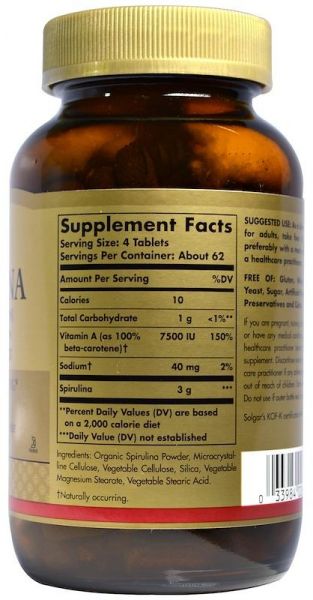 Microalgae are an important source of nutrients. Certain microalgae are commercially available and studies suggest they may possess health benefits when taken as a supplement. Commercially relevant microalgae are the green algae (Chlorophycea) Chlorella vulgaris, Haematococcus pluvialis, Dunaliella salina and the Cyanobacteria Spirulina maxima, which are already widely used as nutritional supplements for humans and as animal feed additives. Because these microalgae photosynthesise, they contain carotenoids, which photosynthesising organism uses as accessory pigments to chlorophyll. Carotenoids in photosynthetic algae include beta carotene and astaxanthin. For example, Dunaliella salina may contain up to 14 % dry weight as astaxanthin. Haematococcus pluvialis is also a rich source of astaxanthin, and is often used as food for farmed salmon, in order to provide the pink colour required for this product. The high antioxidant capacity of photosynthesis algae comes partly from the high carotenoid concentrations, although other antioxidants such as vitamin C and vitamin E are also present.
Microalgae are an important source of nutrients. Certain microalgae are commercially available and studies suggest they may possess health benefits when taken as a supplement. Commercially relevant microalgae are the green algae (Chlorophycea) Chlorella vulgaris, Haematococcus pluvialis, Dunaliella salina and the Cyanobacteria Spirulina maxima, which are already widely used as nutritional supplements for humans and as animal feed additives. Because these microalgae photosynthesise, they contain carotenoids, which photosynthesising organism uses as accessory pigments to chlorophyll. Carotenoids in photosynthetic algae include beta carotene and astaxanthin. For example, Dunaliella salina may contain up to 14 % dry weight as astaxanthin. Haematococcus pluvialis is also a rich source of astaxanthin, and is often used as food for farmed salmon, in order to provide the pink colour required for this product. The high antioxidant capacity of photosynthesis algae comes partly from the high carotenoid concentrations, although other antioxidants such as vitamin C and vitamin E are also present.

Two of the most popular microalgaes on the supplement market are spirulina and chlorella. Both have been extensively investigated for their health effects. These effects likely come from the high density of essential nutrients and the high density of antioxidants in the algae. The carotenoid content of microalgae is often listed on the label of supplements.
Eat Well, Stay Healthy, Protect Yourself
RdB
